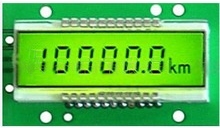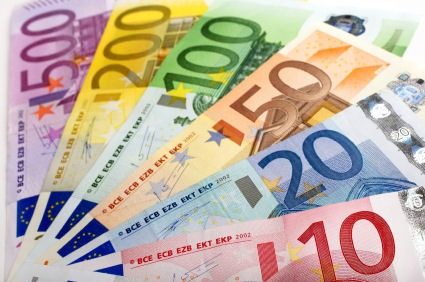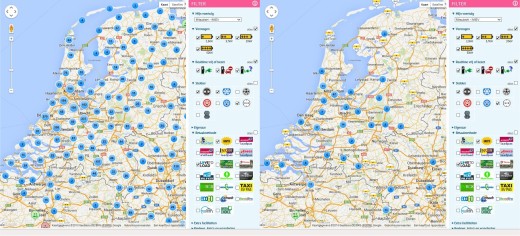
Well, it’s been some time since I last posted a note here. In the mean time I have been experimenting with larger distances… And also I had to get used to the cold weather conditions in relation to the battery-power/range of Mimi.
Luckily I have discovered before that there’s an ANWB service point half-way between Amersfoort and Amsterdam, which has a ChaDeMo-fastcharger available.
So when the cold weather had reduced my range from about 130-140 km regional traffic to a mere 90-100 km when the temperature drops below 10 degrees Celsius, I can still make it to the Amsterdam region (my mom’s place).
One of my trips to there and back was due to a PC monitor breaking down and needing a quick replacement (I had a spare that was not in use). But I wanted to drive back directly and not sit and wait about 3 hours for the range to be sufficient to make it back to Amersfoort.
I calculated that, when I would take a much earlier exit on the highway and drive interregional roads, I would save enough to go from home to my mom and then on the way back make it to the ANWB fastcharger. The ANWB fastcharger was still 31 km seperated from me at my mom’s place.
Though the range reported 42 km remaining, I knew that the range had degraded less significantly, due to driving the last part of the trip interregional with 45-70 km/h. But as soon as I had to accept the last part of my return trip, I would not be able to avoid a highway-part of about 15 km.
Avoiding the highway as long as possible and carefully driving, I could doublecheck with the navigation the remaining kilometers on the range meter would júúúúúúúúst be enough.
Although that empty gastank feeling was already some time ago (mostly my first trip from where I bought Mimi to home was as exciting), I made it with only 7 km on the range and the very last block flashing already some time…
Now on a (inter)regional road, 7 km isn’t that much of a deal, but driving on a highway, not being able to tow or push your car, worse: not being to fill it up with a jerrycan, now that is something different. I was (very) glad my calculations, including the degrading range from the weather conditions, were accurate.
Now that the weather has progressed to spring, and more spring matching temperatures, I decided to work on my latest idea/project. Especially because I have 2 weeks full-time parenting and not need to show up for 2 weeks at work in that time (‘sort-a-vacation’, but I call it: “not needing to attend at work”, since it’s not vacation and had to do several chores besides taking care of my daughter during my wife’s absence).
The challenge:
I want to go budget-shopping at a Kaufland-store in Germany. It’s a cheap supermarket, where we usually buy stuff that we can’t get in the Netherlands or just has a much higher price over here.
We visit the Kaufland only on our way back from holidays, because driving there (and back) just for the purpose of shopping, wouldn’t make sense. At least not budget-wise.
But…, I want to drive there with Mimi. The most near Kaufland for me would likely be the one in Emmerich, just across the border past the (Dutch) city of Arnhem (or in German: Arnheim).
But since the trip will be mostly highway, it’s not likely I’ll make it there on just a fully charged battery of 16 kWh. In the ‘optimum efficiency’ situation, I should be able to make it up to almost 100 km of range, just on the highway, with 84-90 km/h behind some kind of larger vehicle, like a truck.
But the REAL challenge is that I want the trip to Kaufland and back absolutely FREE!
I shall use only free charging points.
At the moment that is not too hard still, because the earlier (on the Blog) mentioned “FastNed” charging stations are still increasing in number and more and more are getting operational. But for a little while they are still in a test phase and charging is free at the moment (and has been since the opening of the first FastNed charging station quite a while ago).
These yellow arch (like half the McDonald’s logo and with solar-panels on the (wooden support pole) roof) stations are located conveniently near highway petrol-stations.
Because I can’t leave with a drained battery, but want to make sure the trip is free, makes that when I return home: the remaining blocks on the fuel/charge-meter should be the same or more.
My goal is to depart with 5 blocks on it (of 16). That enables me to make it to the FastNed facility on the A1 highway near Terschuur (near Barneveld).
Time… is not of essence! So I’ll spend all day on it, if required. But my plan is to depart about 09:00 (after most of the traffic jams have cleared that might have occured during the commuter hours) and spend about 22 minutes at FastNed for charging.
That would mean the time to have evolved to about 10 AM. Then the eco-driving part sets in, driving just over 70 km. Usually that is not a problem, but a fast-charger charges only about 80% fast and then shuts down, if I want more, I’ll have to move the car a few meters from the ChaDeMo-charger to the slow (for me 16A) Mennekes-connection.
For Mennekes-charging sockets I have already used the red/orange cable I bought on eBay before (see earlier in the Blog) some times and it will suit me here fine once again.
So, depending on how things go and how much time I want to spend, I’ll charge a bit longer via the Mennekes-socket.
Then I drive to another FastNed station, located on the A18 highway (just beyond Arnhem), but I should mention that it requires to turn my car around on the following exit, because the FastNed facility over there is located on the ‘way back’.
Because I not need to drive on that highway at all (just a detour of several kilometers for charging there), it’s not of much importance, but it might puzzle you readers when I post my next Blog-entry with the results of the challenge with a GPS data-logger registration in addition to it.
From over there I should be able to make it to Kaufland Emmerich and after shopping, back to that same FastNed facility on the A18 once again. There I’ll charge a third time that day and it would enable me to make it home (barely). But due to the fact that I don’t want to pay anything (just for the ‘fuel’), I might need to charge one more time somewhere to add up to 5 or more blocks before getting home…
If this challenge is succesful, I might skip one or two charge sessions on a next time and try to make it on just 2 charges. And maybe even trying to drive solely on interregional roads not exceeding 80 km/h if that saves me more (charging time) in the end…
With all that in mind, my guess is that it’ll be about 5 PM when I get home.
OK, I’ll keep you updated and posted: Friday is the day.
Those who’ll ecodrive-challenge themselved to Germany and back, greet you! 🙂
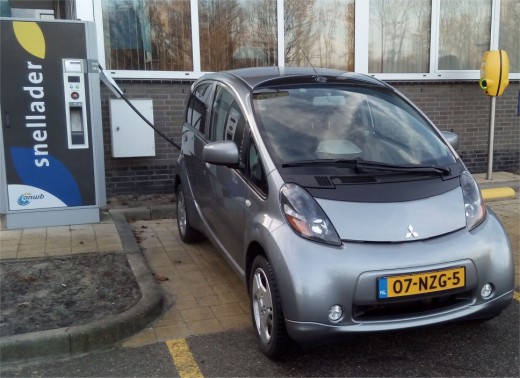
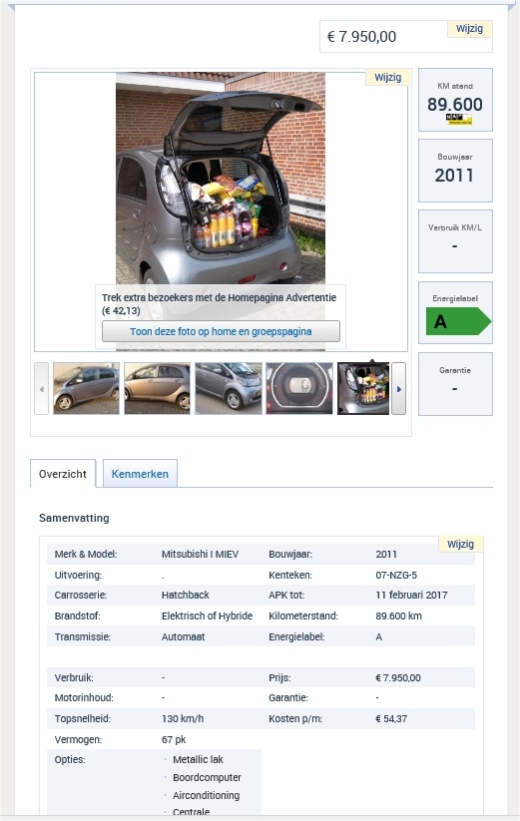 Some few years ago, I was blessed to have been able to purchase and experience my first 100% EV vehicle from the previous owner (who also was blogging about the lovely e-car).
Some few years ago, I was blessed to have been able to purchase and experience my first 100% EV vehicle from the previous owner (who also was blogging about the lovely e-car).![4894278615_81fc7744f2[1]](https://mymiev2.wordpress.com/wp-content/uploads/2016/01/4894278615_81fc7744f21.jpg?w=520)


